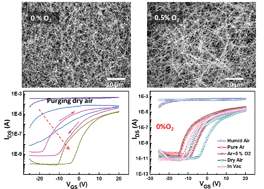The role of tin oxide surface defects in determining nanonet FET response to humidity and photoexcitation†
Abstract
There has been a growing interest in 1-D metal oxide semiconducting nanostructures due to their stable chemical properties and potential applications in large-area, low-cost and flexible substrates. In this current work, we used field effect transistors (FETs) built on sub-millimetre scale metal oxide nanonet to characterize the nanowire surface properties. Two variations of SnO2 nanowires, denoted as 0% O2 and 0.5% O2–Ar, were grown by changing the O2 concentration in the growth atmosphere. HR-TEM images exhibit two dissimilar surface morphologies which represent diverse surface-defect levels. While the devices showed very little semiconducting behaviour in humid air, the flow in the dry air decreased the density of free carriers dramatically. Both water vapour and oxygen were observed to contribute to the hysteresis of transfer curves. Under white light illumination, 0% O2 nanonet devices exhibited a significant photocurrent response in the controlled environment while almost no changes were observed for 0.5% O2 ones. These results confirmed the significant role of surface defects in metal-oxide nanowires and implied great potential for SnO2 nanonet FETs in the application of water gas sensors and photodetectors.


 Please wait while we load your content...
Please wait while we load your content...